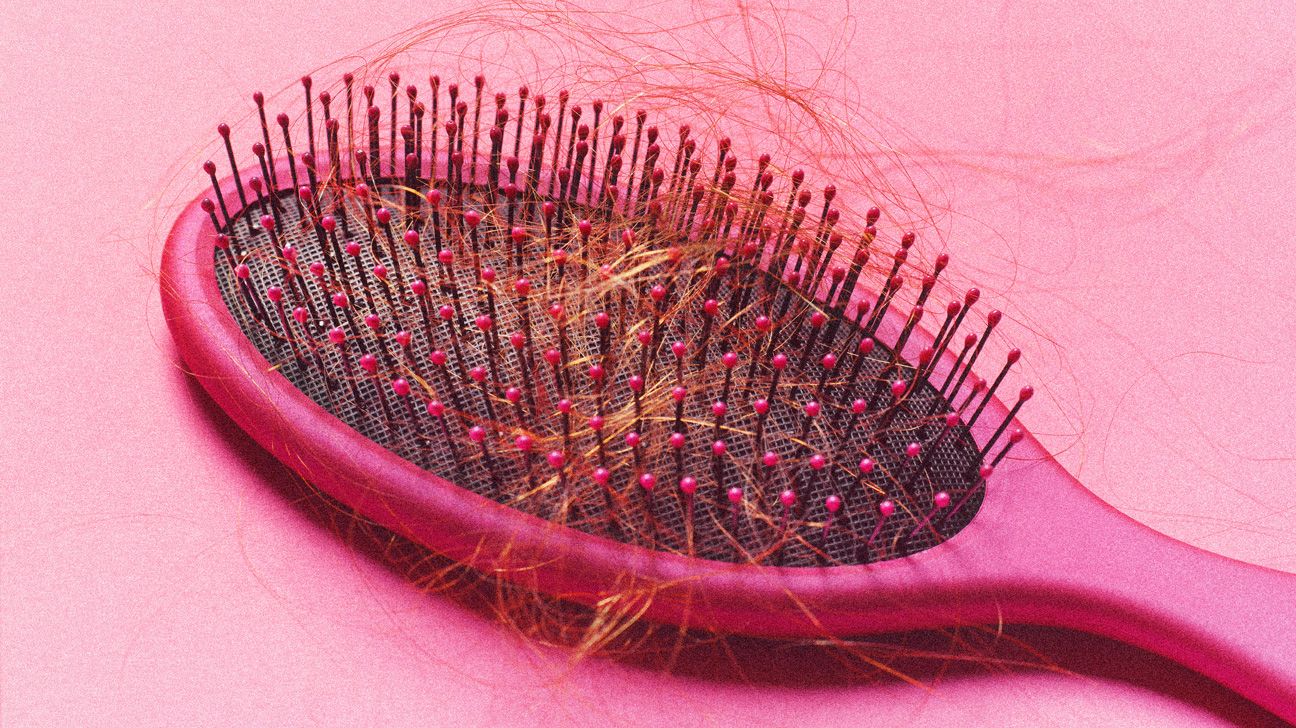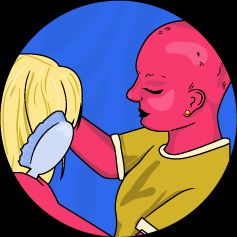Our hair is a huge part of how we’re perceived in this world, and losing it can make us feel frustrated and helpless. If you’re reading this article and dealing with these feelings, you’re not alone!
It’s normal to shed around 100 hairs every single day. No one is holding on to 100% of their hair! But losing more than that could be a sign of hair thinning.
Hair thinning is defined as mild to moderate hair loss, and it can happen to people of any gender or age. But it doesn’t necessarily lead to baldness — and, depending on the cause, it may be treatable. Below, we cover the possible causes as well as common treatment options.

While it’s great to stay informed about your health, there are many causes of hair thinning, and the best course of action is always to seek professional help for diagnosis and treatment.
Treating based on self-diagnosis could lead to other problems down the road. So think of this as an intro guide to inform your conversation with a professional.
| Cause | Other symptoms to look out for | Possible treatment |
|---|---|---|
| an autoimmune disease or immune deficiencies | • fever • fatigue • rashes • muscle aches • swelling • redness | It depends on the disease, but corticosteroids could be a good fit. |
| hormonal changes, including pregnancy, childbirth, menopause, and birth control use | many but can include: • sudden weight or mood changes • muscle/joint pain or stiffness • a lump of fat between your shoulders | spironolactone (Aldactone) |
| vitamin deficiencies | many but can include: • poor night vision • bone and joint pain • irregular heart rate • slow wound healing | vitamin supplements |
| thyroid issues | • changes in weight or menstrual cycle • stomach issues • heart palpitations • depression | Talk with a doctor about blood testing and medication. |
| skin/scalp infection | • inflamed, scaly scalp • acne-like marks • hard nodes on hair | It depends on the infection, but ketoconazole shampoo may work. |
| excessive stress | can have many physical symptoms, including headaches and heart palpitations | Check out our guide to reducing stress. |
| eating disorders | • weight changes • changes in skin condition • loss of tooth enamel | Please talk with a doctor or therapist. |
| use of harsh hair products such as dyes, bleaches, perms, relaxers, and styling products | • scalp irritation or damage • dry, damaged hair | • discontinuing use of products • possibly platelet-rich plasma |
| frequent too-tight hairstyles | • scalp irritation • hair breakage | phenylephrine |
How to know whether it’s alopecia areata
Alopecia areata is an autoimmune disorder that causes hair loss (usually on your scalp, but it can also affect other parts of your body). It involves a sudden onset of patchy hair loss. Most cases start before a person hits their 30s.
As you seek treatment, remember to be patient with yourself. Medications work differently for everyone, and you may not find the right treatment on your first go.
Additionally, many hair growth medications don’t provide permanent results. This means that if you stop using them, any positive results will fade.
Minoxidil (Rogaine)
Minoxidil is a well-known hair growth treatment. Give it at least 2 months to start producing hair regrowth, applying it to your scalp twice daily for the best results. But expect to see the results diminish when you stop using minoxidil.
Possible side effects of minoxidil
- increased heart rate
- difficulty breathing
- swelling (edema)
- seborrheic dermatitis
- scalp itching
- scaling
Phenylephrine
Topically applied phenylephrine makes follicle muscles contract, which can increase your hair’s resistance to falling out (such as from brushing or other tension). One study used a formulation that decreased shedding from brushing by almost 40%.
But phenylephrine may affect your heart, so talk with a doctor before using it.
Platelet-rich plasma (PRP) injections
PRP injections are a possible option, especially if your hair loss does not respond to topical hair-restoring treatments.
Made with isolated platelets (cell fragments) taken from your own blood, the injections have a healing, rejuvenating effect. (You might have heard about Kim Kardashian’s “vampire facial” — those were PRP injections.)
There isn’t a ton of conclusive research on PRP injections for hair growth. Future studies should continue to examine the hair-promoting mechanisms of PRP. The treatment is beneficial because it has few side effects since your body is unlikely to reject its own blood.
In a 2022 study, researchers divided participants into two groups. Group 1 received three monthly PRP treatments with a booster 2 months later, and group 2 had two PRP treatments 3 months apart.
After 3 months, only group 1 had statistically significant hair growth. Group 2 did not have significant hair growth until 6 months after the first injection. These results suggest that more frequent PRP treatments could increase hair growth, but this treatment method needs more examination.
Spironolactone (Aldactone)
Spironolactone works by inhibiting androgens such as testosterone, which can speed up hair loss in females. It’s commonly recommended for people with hormonal issues.
But if you’re pregnant or thinking about getting pregnant, you shouldn’t take spironolactone because it can cause problems for newborns. It can also cause changes in weight, mood, and energy.
Oral finasteride
Finasteride is a prescription drug for males that can be taken orally to slow down hair loss and possibly increase hair growth.
Most people will notice a difference within 3 months of use. But finasteride is not a permanent fix.
Dangerous for females
Females and pregnant people should stay far away from this drug, as it can have dangerous side effects.
While some people swear by the methods listed below, none of these methods are backed by enough research to say whether they’re truly effective. Please proceed with caution if you choose to try them. And as always, make sure to patch test new products to avoid any widespread reactions.
Scalp massage
Scalp massage is a popular remedy for hair growth in internet spaces. In one survey with more than 300 participants, 68.9% of participants reported increased hair growth or stabilization of hair loss after completing 11–20 minutes of scalp massage daily for up to 14 months.
However, that’s not the same as increasing the density of your hair or the number of hairs on your head, so this might not be the best solution for some people on its own.
Onion juice
Some small studies have suggested that applying onion juice to your scalp can kick-start hair growth. While the research is slim, it’s possible that onion extract could improve hair growth and protect against oxidative cellular damage due to stress.
Laser therapy
While low level laser light therapy hasn’t been tested on general hair thinning, some studies have shown it to be effective in increasing hair growth in males and females with androgenetic alopecia. While it’s pricey, it’s a noninvasive treatment and has no side effects to speak of.
Essential oils
A few small studies have suggested that essential oils could affect hair growth. One study with 100 participants found similar hair growth results in people treated with rosemary oil and in those treated with minoxidil 2%.
Additionally, the authors of a 2024 mini-review examined the effect of lavender, rosemary, peppermint, and cedarwood oils on the hair follicle cycle, cellular metabolism, and scalp inflammation.
They found that lavender oil could increase the amount and depth of hair follicles in mice and that rosemary oil increased hair count and thickness. Peppermint oil could increase dermal thickness, follicle number, and follicle depth in mice. And cedarwood oil improved hair growth, potentially by regulating the immune system and reducing inflammation.
Essential oils can cause chemical burns to your skin, so be sure to dilute them with a carrier oil if you choose to try this method.
While research suggests there are health benefits, the Food and Drug Administration (FDA) doesn’t monitor or regulate the purity or quality of essential oils. It’s important to talk with a healthcare professional before you begin using essential oils and to research the quality of a brand’s products. Always do a patch test before trying a new essential oil.
Anti-thinning shampoo
Some shampoos are loaded with antioxidants and amino acids that promote a healthy scalp and thus thicker hair. You can buy one over the counter, but you can also talk with a doctor about prescription versions if you feel you need extra strength.
Stress management
Stress and hair loss can become a vicious cycle: Stress can lead to hair loss, which can lead to more stress, which can lead to more hair loss. But there are proven ways to stop this cycle in its tracks. Meditation, calming music, and even laughter are scientifically proven ways to de-stress.
Sometimes nutrient deficiencies can cause hair loss. But it’s best to talk with a medical professional before you go shopping for supplements.
Iron, folic acid, and zinc
While it’s true that hair needs iron, folic acid, and zinc to grow and stay healthy, there’s conflicting evidence as to whether taking these supplements will help stop hair loss.
Omega-3 and omega-6 supplements
Don’t skimp on nuts, fish, and leafy greens! Omega-3 and omega-6 fatty acids are important for keeping your brain and heart healthy and fortifying your body against inflammation. Besides hair loss, severe deficiencies of these fats can lead to skin issues and even arthritis.
Check with a healthcare professional to find out whether you could benefit from increasing your intake.
Forget biotin
You may have heard that biotin is good for hair health. But a 2017 review on the subject found that while this vitamin is important for healthy nail and hair growth, biotin deficiency is quite rare.
There isn’t enough evidence to recommend supplementing for most people. Isn’t it a relief to have one fewer vitamin to worry about?
A variety of conditions and circumstances can lead to hair loss, and there are many possible ways to treat it — with or without medication.
Finding the right treatment will depend on figuring out the underlying cause of your hair loss. And for that, you’ll need to work with a medical professional. Otherwise, you may end up spending a lot of money on something that was never going to work in the first place.
It’s natural to feel anxious about hair thinning, but for most people, hair thinning is not a sign of baldness to come. Remember that you’re the most intimate with your own reflection, and the problem probably isn’t as obvious to others as you think.

